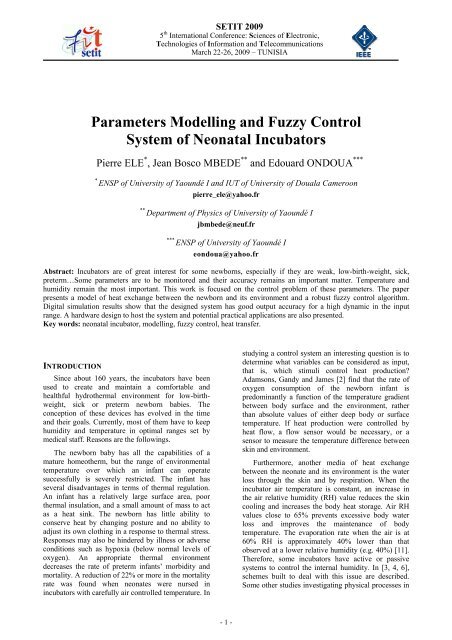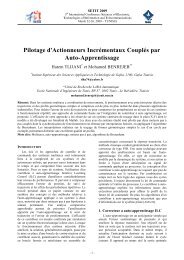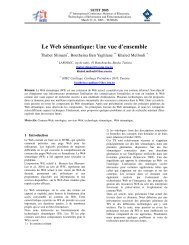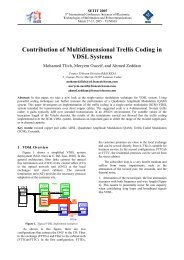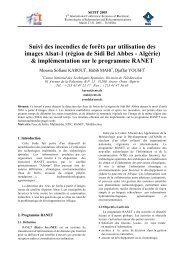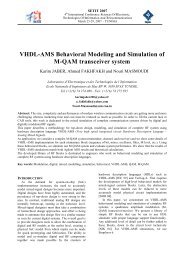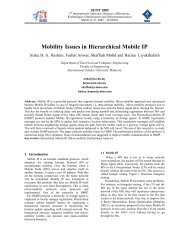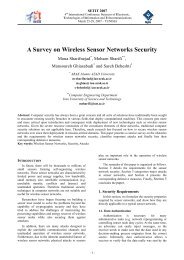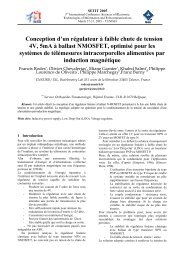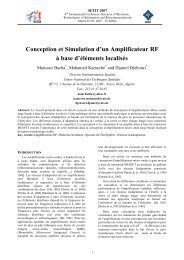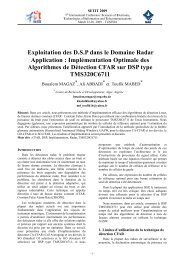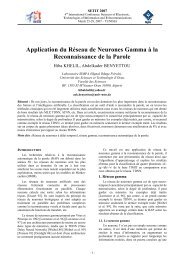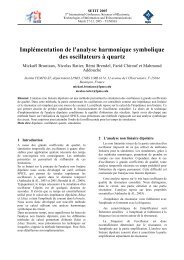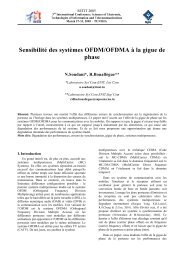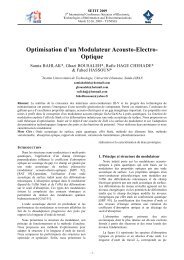Parameters Modelling and Fuzzy Control System of Neonatal ...
Parameters Modelling and Fuzzy Control System of Neonatal ...
Parameters Modelling and Fuzzy Control System of Neonatal ...
Create successful ePaper yourself
Turn your PDF publications into a flip-book with our unique Google optimized e-Paper software.
SETIT 2009<br />
5 th International Conference: Sciences <strong>of</strong> Electronic,<br />
Technologies <strong>of</strong> Information <strong>and</strong> Telecommunications<br />
March 22-26, 2009 – TUNISIA<br />
<strong>Parameters</strong> <strong>Modelling</strong> <strong>and</strong> <strong>Fuzzy</strong> <strong>Control</strong><br />
<strong>System</strong> <strong>of</strong> <strong>Neonatal</strong> Incubators<br />
Pierre ELE * , Jean Bosco MBEDE ** <strong>and</strong> Edouard ONDOUA ***<br />
* ENSP <strong>of</strong> University <strong>of</strong> Yaoundé I <strong>and</strong> IUT <strong>of</strong> University <strong>of</strong> Douala Cameroon<br />
pierre_ele@yahoo.fr<br />
** Department <strong>of</strong> Physics <strong>of</strong> University <strong>of</strong> Yaoundé I<br />
jbmbede@neuf.fr<br />
*** ENSP <strong>of</strong> University <strong>of</strong> Yaoundé I<br />
eondoua@yahoo.fr<br />
Abstract: Incubators are <strong>of</strong> great interest for some newborns, especially if they are weak, low-birth-weight, sick,<br />
preterm…Some parameters are to be monitored <strong>and</strong> their accuracy remains an important matter. Temperature <strong>and</strong><br />
humidity remain the most important. This work is focused on the control problem <strong>of</strong> these parameters. The paper<br />
presents a model <strong>of</strong> heat exchange between the newborn <strong>and</strong> its environment <strong>and</strong> a robust fuzzy control algorithm.<br />
Digital simulation results show that the designed system has good output accuracy for a high dynamic in the input<br />
range. A hardware design to host the system <strong>and</strong> potential practical applications are also presented.<br />
Key words: neonatal incubator, modelling, fuzzy control, heat transfer.<br />
INTRODUCTION<br />
Since about 160 years, the incubators have been<br />
used to create <strong>and</strong> maintain a comfortable <strong>and</strong><br />
healthful hydrothermal environment for low-birthweight,<br />
sick or preterm newborn babies. The<br />
conception <strong>of</strong> these devices has evolved in the time<br />
<strong>and</strong> their goals. Currently, most <strong>of</strong> them have to keep<br />
humidity <strong>and</strong> temperature in optimal ranges set by<br />
medical staff. Reasons are the followings.<br />
The newborn baby has all the capabilities <strong>of</strong> a<br />
mature homeotherm, but the range <strong>of</strong> environmental<br />
temperature over which an infant can operate<br />
successfully is severely restricted. The infant has<br />
several disadvantages in terms <strong>of</strong> thermal regulation.<br />
An infant has a relatively large surface area, poor<br />
thermal insulation, <strong>and</strong> a small amount <strong>of</strong> mass to act<br />
as a heat sink. The newborn has little ability to<br />
conserve heat by changing posture <strong>and</strong> no ability to<br />
adjust its own clothing in a response to thermal stress.<br />
Responses may also be hindered by illness or adverse<br />
conditions such as hypoxia (below normal levels <strong>of</strong><br />
oxygen). An appropriate thermal environment<br />
decreases the rate <strong>of</strong> preterm infants’ morbidity <strong>and</strong><br />
mortality. A reduction <strong>of</strong> 22% or more in the mortality<br />
rate was found when neonates were nursed in<br />
incubators with carefully air controlled temperature. In<br />
studying a control system an interesting question is to<br />
determine what variables can be considered as input,<br />
that is, which stimuli control heat production?<br />
Adamsons, G<strong>and</strong>y <strong>and</strong> James [2] find that the rate <strong>of</strong><br />
oxygen consumption <strong>of</strong> the newborn infant is<br />
predominantly a function <strong>of</strong> the temperature gradient<br />
between body surface <strong>and</strong> the environment, rather<br />
than absolute values <strong>of</strong> either deep body or surface<br />
temperature. If heat production were controlled by<br />
heat flow, a flow sensor would be necessary, or a<br />
sensor to measure the temperature difference between<br />
skin <strong>and</strong> environment.<br />
Furthermore, another media <strong>of</strong> heat exchange<br />
between the neonate <strong>and</strong> its environment is the water<br />
loss through the skin <strong>and</strong> by respiration. When the<br />
incubator air temperature is constant, an increase in<br />
the air relative humidity (RH) value reduces the skin<br />
cooling <strong>and</strong> increases the body heat storage. Air RH<br />
values close to 65% prevents excessive body water<br />
loss <strong>and</strong> improves the maintenance <strong>of</strong> body<br />
temperature. The evaporation rate when the air is at<br />
60% RH is approximately 40% lower than that<br />
observed at a lower relative humidity (e.g. 40%) [11].<br />
Therefore, some incubators have active or passive<br />
systems to control the internal humidity. In [3, 4, 6],<br />
schemes built to deal with this issue are described.<br />
Some other studies investigating physical processes in<br />
- 1 -
SETIT2009<br />
incubators have carried out numerical or experimental<br />
techniques [5, 8, 9]. The major objectives <strong>of</strong> these<br />
studies are heat losses <strong>of</strong> the neonate, temperature<br />
distribution, air flow, humidity control <strong>and</strong> a better<br />
insight <strong>of</strong> the thermal interactions between the neonate<br />
<strong>and</strong> its surrounding environment. In this paper, the<br />
problem <strong>of</strong> heat transfer modelling is tackled, in the<br />
perspective <strong>of</strong> robust temperature control.<br />
The rest <strong>of</strong> the paper is organized as follows. In the<br />
next section, the description <strong>of</strong> the process with<br />
relevant signals is presented. The thermal<br />
characterisation <strong>of</strong> the neonate <strong>and</strong> its environment is<br />
complex <strong>and</strong> not well understood. But, they determine<br />
the actual temperature in the incubator. A<br />
mathematical heat transfer model is presented in the<br />
section two. Our model is combining passive heat<br />
losses <strong>and</strong> active heat production both from internal<br />
(infant) <strong>and</strong> external sources. A robust control system<br />
is presented in the third section, followed in section<br />
four by simulation results validating our approach. We<br />
then present potential applications <strong>of</strong> our system.<br />
Finally, conclusions are addressed with attention<br />
paid to neur<strong>of</strong>uzzy control or energy efficiency as<br />
future work.<br />
1. Process description<br />
1.1. Neonate’s room<br />
It has been drawn in the figure 1 the simplified cross<br />
section <strong>of</strong> the chamber where babies are laid down.<br />
d<br />
w<br />
Figure 1. Room for babies. Arrows indicate heating<br />
air flow.<br />
Walls are in plexiglas or such kind <strong>of</strong> material. A<br />
mattress is sketched inside the room. The room is not<br />
hermetic. Many small holes are provided for air<br />
admission <strong>and</strong> expelling. There are also holes to<br />
connect other monitoring apparatus to the baby in the<br />
incubator. Room dimensions are approximately:<br />
Wall width d between 5 <strong>and</strong> 10 mm<br />
Height h between 40 <strong>and</strong> 80 cm<br />
Width w between 50 <strong>and</strong> 100 cm<br />
Length l between 70 <strong>and</strong> 150 cm<br />
The control system will be located at the bottom <strong>of</strong><br />
the room. Sensors are placed on air inlets <strong>and</strong> outlet or<br />
tapped on the infant skin.<br />
h<br />
1.2. Signals description<br />
1.2.1 Temperature<br />
Temperature is kept on a fixed value that medical<br />
staff can choose around values between 27 <strong>and</strong> 39°C.<br />
The precision around a setpoint Ts is ±δ where δ≤0.5<br />
°C. The temperature must be kept in these bounds<br />
though air is being renewed. If the temperature falls<br />
out <strong>of</strong> the bounds, an alarm should sound <strong>and</strong>/or<br />
display. Temperature is considered as the most critical<br />
parameter. Particularly, for preterm neonates, the<br />
internal control mechanisms <strong>of</strong> temperature are not<br />
well developed as in an adult <strong>and</strong> the survival depends<br />
on external control. For improving reliability, heating<br />
with resistors <strong>and</strong> redundant temperature sensing are<br />
proposed. For more universality <strong>of</strong> our system, the<br />
range <strong>of</strong> controlled temperature will be enlarged, as<br />
air, skin <strong>and</strong> core temperature (to name a few) will be<br />
controlled.<br />
1.2.2 Humidity<br />
The simplest way to moisten the room air is to<br />
force (by a fan) the air flux passing above a water tank<br />
before it goes through holes to babies’ room. The<br />
adjustment <strong>of</strong> the air-water contact surface leads to the<br />
hygrometric regulation. The value can be set to a point<br />
between 44 <strong>and</strong> 95%. Levels recommended in the<br />
literature are located between 65 <strong>and</strong> 90%. As till to<br />
now, this parameter needs not high precision, its<br />
adjustment is done sometimes manually. Humidity is<br />
linked to temperature. But the important point is to<br />
make sure that the fan is running. Otherwise, an alarm<br />
must sound. The alarm sounds also if water level in<br />
the tank is too low.<br />
1.2.3 Oxygen<br />
Oxygenation can be obtained without a particular<br />
effort with the air circulation. And holes are on the<br />
walls <strong>of</strong> the room. Oxygen consumption measurement<br />
can also inform on the metabolic heat production.<br />
1.2.4 Breathing signal<br />
The matter is that it happens for baby to "forget"<br />
breathing (apnoea). The outcome <strong>of</strong> this might be the<br />
death. One must then be sure the baby is breathing<br />
normally. Expelled <strong>and</strong> incoming air to lungs have<br />
different temperatures: thus, as a simple <strong>and</strong> low cost<br />
sensing system, current/potential difference variations<br />
across a thermistance located at the baby nose can be<br />
monitored. But the two temperatures can be very close<br />
<strong>and</strong> their difference is a time varying phenomenon.<br />
Moreover, baby’s movements constitute artifacts<br />
sources that can be superimposed to the signal. Preprocessing<br />
is useful to avoid false decision. An alarm<br />
is also needed here if the breathing is going wrong.<br />
1.2.5 Other signals<br />
Miscellaneous other signals, particularly from the<br />
baby body (weight, baby temperature,<br />
electrophysiological signals as ECG or EMG…) are<br />
now generally sensed <strong>and</strong> processed by powerful<br />
external equipments. They are foreseen in our system,<br />
but are not our concern for the moment<br />
- 2 -
SETIT2009<br />
Digital signal processing to be done includes but is<br />
not limited to filtering for all these parameters to get<br />
ride <strong>of</strong> noise, compression algorithm to monitor some<br />
parameters, as memory space will be narrow for this<br />
low cost system<br />
2. Heat exchange modelling<br />
The flow <strong>of</strong> the air <strong>and</strong> position <strong>of</strong> circuit elements<br />
are sketched below in figure 2.<br />
Air pushed<br />
by the fan<br />
Water<br />
tank<br />
Heating<br />
resistor<br />
Electric<br />
Power<br />
Figure 2. Air flow circuit.<br />
The metabolic heat generated by the baby is either<br />
stored or dissipated to the surrounding environment<br />
due to conduction, radiation, convection, <strong>and</strong><br />
evaporation <strong>of</strong> water from the skin <strong>and</strong> respiratory<br />
track (see on figure 3).<br />
Figure 3. Heat losses sources.<br />
Temper<br />
ature<br />
sensor<br />
However, since the heat transfer processes <strong>of</strong> this<br />
study are considered in a steady state, accumulation<br />
terms have not been taken into account. An energy<br />
balance equation can therefore be written as on<br />
equation (1).<br />
Q M + Q H = Q con + Q rad + Q cov + Q evp (1)<br />
Q M is the metabolic heat production term <strong>and</strong> Q H<br />
the external stimuli is generated by the input energy<br />
source (<strong>of</strong>ten a heating resistor as sketched on figure 2<br />
above).<br />
QM can be obtained empirically by the formula (2)<br />
written below [1].<br />
Q M = 3.815 ·VO2 + 1.232 ·VCO2 (kcal/L) (2)<br />
VO2: oxygen consumption<br />
VCO2: carbon dioxide production<br />
Babies<br />
room<br />
Q M can be calculated also by the formula (3).<br />
Q M 0.0522mp 1.64 (3)<br />
Outside<br />
m is the baby weight (kg) <strong>and</strong> p is the baby’s age<br />
(days).<br />
QH which can be electrical energy is determined<br />
using relation (4).<br />
QH = Mae Ca (Tai-Te) (4)<br />
Mae, Ca <strong>and</strong> Te are the mass, the specific heat <strong>and</strong><br />
the temperature <strong>of</strong> the external air entering the<br />
incubator. This is the input air arriving on the tank<br />
(see on the block diagram <strong>of</strong> figure 2). Tai is the<br />
temperature <strong>of</strong> air entering the chamber (after the<br />
heating block <strong>of</strong> figure 2).<br />
The right h<strong>and</strong> terms <strong>of</strong> equation (1) can be<br />
determined as below.<br />
A - Q con Conduction heat loss<br />
Conduction heat loss between infant <strong>and</strong> mattress<br />
can be neglected. This is a reasonable assumption<br />
following Wheldon [7] who states that the rate <strong>of</strong> heat<br />
transfer by conduction is small for a baby lying on a<br />
foam mattress.<br />
B - Q evp Evaporation heat loss<br />
Q evp = m v h fg + Qcov-lu (5)<br />
In the equation (5), m v is the rate <strong>of</strong> evaporation<br />
from the body (kg/s) <strong>and</strong> h fg is the enthalpy <strong>of</strong><br />
vaporisation <strong>of</strong> water (kJ/kg). Qcov-lu which is the<br />
convective heat loss in the lungs is proportional to the<br />
difference between core (deep body) <strong>and</strong> ambient air<br />
temperature.<br />
Qcov-lu = MaCa(Tcr-Ta) (6)<br />
Ma <strong>and</strong> Ca are the mass <strong>and</strong> the specific heat <strong>of</strong><br />
the intake air respectively.<br />
C - Q cov Convective heat loss<br />
The convective heat exchange is proportional to<br />
the temperature difference between skin temperature<br />
Ts <strong>and</strong> ambient one Ta, to hc (W/m 2 °C) <strong>and</strong> to the<br />
area A as shown by equation (7).<br />
Q cov = hc(Ts – Ta)A (7)<br />
D - Q rad Radiative heat loss<br />
Similarly the radiative heat loss can be formulated<br />
as follows in (8) [7]<br />
Q rad = σε(Ts 4 – Tr 4 )A (8)<br />
In relation (8), σ is the Stefan-Boltzmann constant<br />
<strong>and</strong> is measured in watts per meter squared per degree<br />
Celsius power 4, ε is the emissivity <strong>and</strong> Tr is the mean<br />
temperature (°C) calculated from the incubator.<br />
The energy balance equation must be completed<br />
by the heat transfer analysis energy equation [7-8]<br />
below.<br />
- 3 -
SETIT2009<br />
dT<br />
∇ ( k∇T)<br />
= ρc<br />
(9)<br />
dt<br />
In the equation (9), T is the temperature (K), k is<br />
the thermal conductivity (W/mK), ρ is the density<br />
(kg/m 3 ), c is the specific heat (W/kgK), <strong>and</strong> t is time<br />
(s). The derivative on the right-h<strong>and</strong> side <strong>of</strong> equation<br />
is the total derivative:<br />
dT ∂T<br />
∂T<br />
∂T<br />
∂T<br />
∂T<br />
= + ux<br />
+ uy<br />
+ uz<br />
= + u∇T<br />
(10)<br />
dt ∂t<br />
∂x<br />
∂y<br />
∂z<br />
∂t<br />
There, u x , u y , <strong>and</strong> u z , are the velocity components<br />
<strong>of</strong> vector u in the x-, y-, z-direction, respectively (m/s).<br />
Since only steady-state problems are studied in this<br />
work, the first term on the right-h<strong>and</strong> side <strong>of</strong> equation<br />
vanishes.<br />
The above equations are complemented by the<br />
continuity <strong>and</strong> momentum equations [21], namely<br />
u 0 (11)<br />
ρ du = F − ∇p<br />
+ µ ∇<br />
2 u<br />
dt<br />
(12)<br />
In (12), p is the pressure (N/m2), F represents the<br />
body force term which in the present case has only a<br />
vertical component Fz = g in the z-direction<br />
(N/m2), g is gravity acceleration (m/s2) <strong>and</strong> µ is the<br />
dynamic viscosity (Ns/m2).<br />
The Boussinesq approximation was adopted for the<br />
buoyancy term in equation (12). Thus, density takes<br />
the usual form in equation (13).<br />
= T T 0 )) (13)<br />
is the thermal expansion coefficient (1/K), T0<br />
<strong>and</strong> represent the operating parameters.<br />
3. <strong>Fuzzy</strong> control system<br />
As an implantation <strong>of</strong> a control system, the<br />
constraints are that the system must be simple, cheap,<br />
versatile <strong>and</strong> universal for multiple usages, compact<br />
<strong>and</strong> reliable. In the other h<strong>and</strong>, complexity <strong>of</strong> the<br />
system is such that some uncertainties/assumptions are<br />
not taken into account in models. Singh [10] choice is<br />
a microcontroller with a classical control. Here also, a<br />
microcontroller hardware feedback system can be<br />
proposed, but, with a fuzzy processing algorithm<br />
approach to ensure robustness. Zadeh [15] has<br />
summarised fuzzy logic as a body <strong>of</strong> concepts <strong>and</strong><br />
techniques for dealing with imprecisions, information<br />
granulation, approximate reasoning <strong>and</strong> computing<br />
with words.<br />
While many different control system algorithms or<br />
control loops exist (e.g. “on/<strong>of</strong>f”, linear or fractional<br />
order control), it is important to chose one well suited<br />
to the application <strong>and</strong> system requirements. PID<br />
(proportional integral derivative) controllers have been<br />
long known for being effective in control <strong>and</strong><br />
regulation <strong>of</strong> thermal systems. Each <strong>of</strong> the terms,<br />
“proportional”, “integral” <strong>and</strong> “derivative” refers to<br />
one <strong>of</strong> the three basic elements <strong>of</strong> a PID controller.<br />
Each <strong>of</strong> these elements performs a different task <strong>and</strong><br />
has a different effect on the function <strong>of</strong> a system. The<br />
system can be described mathematically through<br />
general equation (11) where E(t) is the error, K P , K I<br />
<strong>and</strong> K D are the proportional, integral <strong>and</strong> derivative<br />
constants respectively <strong>and</strong> C(t) is the control output <strong>of</strong><br />
the system.<br />
C(t)<br />
t<br />
dE(t)<br />
= K P E(t) + K I∫ E(t)dt + K D<br />
(14)<br />
dt<br />
0<br />
A PID controller attempts to control temperature at<br />
some value T set by looking at the current error, past<br />
error <strong>and</strong> predicting future error. The output accuracy<br />
depends strongly <strong>of</strong> the accuracy <strong>of</strong> the model. Beside<br />
this drawback, a risk <strong>of</strong> computations overhead for the<br />
18F452 microcontroller also exists. The fuzzy<br />
approach is then proposed.<br />
The 2 inputs variables are temperature <strong>and</strong><br />
moisture. Membership functions <strong>of</strong> triangular shape<br />
were tried with satisfaction. For temperature linguistic<br />
variable considered with n sets, we have the figure 4<br />
representation.<br />
-1<br />
µ degree <strong>of</strong><br />
membership<br />
Figure 4. Type <strong>of</strong> membership functions used.<br />
This st<strong>and</strong>ard universe [-1, 1] is postprocessed to<br />
[20°C, 40°C] range.<br />
Inferences were based on set <strong>of</strong> rules we built. The<br />
Mamdani-type inference was used. The<br />
defuzzification process choice is the most widely used<br />
centre <strong>of</strong> gravity (centroid) one [15].<br />
4. Simulation results<br />
A sample <strong>of</strong> simulations curves <strong>of</strong> the output<br />
signal (temperature or humidity) is given below in he<br />
figure 5.<br />
1<br />
T °C<br />
1<br />
- 4 -
SETIT2009<br />
limit is exceeded <strong>and</strong> when spare parts no longer exist<br />
or have never existed on the market. Obsolete<br />
apparatus or equipments donated to developing<br />
countries are good examples. Trying to find the<br />
defective electronic component in the control system<br />
is not always applicable. Thus very expensive types <strong>of</strong><br />
equipment are thrown away. Note the defective<br />
intelligent part weights just a small percentage <strong>of</strong> the<br />
overall cost <strong>of</strong> the equipment.<br />
Upper<br />
Lower<br />
Figure 5. Sample curves showing the control quality<br />
<strong>of</strong> parameters: temperature (upper) <strong>and</strong> humidity<br />
(lower).<br />
Output is tracking with a very good accuracy the<br />
setpoint. This is particularly true for temperature. This<br />
is also the case in the literature where tolerances are<br />
around 0.1 <strong>and</strong> 0.5 degree respectively for temperature<br />
<strong>and</strong> RH. We are thus optimistic for the actual<br />
implantation.<br />
But, with less than n=4 membership functions, we<br />
had instability. For a set <strong>of</strong> rules between 8 <strong>and</strong> 10, we<br />
noticed not a great modification in the accuracy.<br />
5. Potential practical applications<br />
Incubators are <strong>of</strong>ten out <strong>of</strong> service because <strong>of</strong> a<br />
breakdown <strong>of</strong> the electronic part, while the guarantee<br />
The technical contribution based on this work <strong>and</strong><br />
presented here is an alternative robust, compact,<br />
simple, universal <strong>and</strong> low cost system that can replace<br />
the original part assist maintenance services <strong>and</strong><br />
medical staff in sanitarian structures. The robustness<br />
allows using this for different kinds <strong>of</strong> neonatal<br />
incubators <strong>and</strong> probably for eggs incubators where we<br />
are dealing with the same major parameters but to be<br />
adjusted in other ranges. Temperature <strong>and</strong> moisture<br />
are also the parameters considered while investigating<br />
thermal comfort in buildings. And this is another<br />
potential application.<br />
A hardware <strong>of</strong> such a closed-loop system designed<br />
around a Microchip 18F452 microcontroller [13] is<br />
following. This integrated circuit contains in a single<br />
40 pins (DIL or PLCC) package:<br />
- 1 RISC (Reduced Instruction Set Computer) CPU<br />
- 32 kilo bytes <strong>of</strong> flash memory; they will be used for<br />
programs storage<br />
- 256 bytes <strong>of</strong> EEPROM; they will retain some<br />
parameters as set points)<br />
- 1536 bytes for scratch RAM, stack…<br />
- 34 I/O lines; some will be used for control, alarms,<br />
displaying <strong>and</strong> communications purpose<br />
- 4 timers for counting <strong>and</strong> time measurements. They<br />
will be <strong>of</strong> great interest for the s<strong>of</strong>tware cycling,<br />
generation <strong>and</strong> h<strong>and</strong>ling <strong>of</strong> interruptions<br />
- 2 PWM modules; one will be used for the control <strong>of</strong><br />
the temperature<br />
- 8 channels, 10 bits A/D converter; they will be used<br />
for parameters acquisition<br />
- 1 watch dog to recover from program break down.<br />
Such a single integrated circuit allows the<br />
fulfilment <strong>of</strong> many conditions (simple, cheap,<br />
versatile, compact <strong>and</strong> reliable).<br />
After completing the clock system by adding an<br />
external crystal <strong>and</strong> 2 capacitors, one has an in situ<br />
programmable system working at 40 MHz. The in situ<br />
programmable characteristic is very valuable for<br />
future extensions. This ensures versatility <strong>and</strong><br />
universality.<br />
We have drawn the block diagram <strong>of</strong> the hardware<br />
below in figure 6.<br />
- 5 -
SETIT2009<br />
newborn human infant”, J. Pediatrics, vol 66, pp. 495-<br />
508, 1965.<br />
[3] M. F. Amorim, “Contribution à la Conception et au<br />
Developpement d'un Nouvel Incubateur: Système de<br />
Contrôle d'Humidité et Monitorage Cardio-respiratoire”,<br />
PhD thesis, Université Technologie de Compiègne,<br />
1994.<br />
[4] D. Bouattoura, P. Villon <strong>and</strong> G. Farges, “Dynamic<br />
programming approach for newborn's incubator<br />
humidity control”, IEEE Trans. on Biomedical Eng.<br />
45(1), pp. 48-55, 1998.<br />
Figure 6. Hardware <strong>of</strong> the processing <strong>and</strong> closed-loop<br />
control system.<br />
For security <strong>and</strong> reliability issues, some parameters<br />
are picked up redundantly by at least 2 sensors. This<br />
will be the case for temperature <strong>and</strong> breathing.<br />
The computer used for programs development <strong>and</strong><br />
downloading to the system is not represented in the<br />
figure.<br />
6. Conclusion<br />
A simple alternative system for detection, digital<br />
processing <strong>of</strong> an incubator parameters has been<br />
presented. A mathematical model was developed for a<br />
better insight <strong>of</strong> heat transfer phenomena. Before, we<br />
had a stalemate where our proposal is a useful<br />
solution. New aspects include universality, versatility<br />
<strong>and</strong> the possibility to sense <strong>and</strong> process parameters<br />
usually left to external powerful equipment linked to<br />
incubator. The accuracy expected for targeted<br />
parameters values will be higher, since computations<br />
potential available let to robust fuzzy control which is<br />
not used in this kind <strong>of</strong> system till to now.<br />
For the future, an important question is whether a<br />
neuro-fuzzy <strong>and</strong> fuzzy-GA based approaches are<br />
useful. Our expectations should be satisfied. But, if<br />
not, thanks to the in situ programming capability <strong>of</strong><br />
the system, the synergy provided by the combination<br />
<strong>of</strong> fuzzy <strong>and</strong> neural systems can easily be introduced.<br />
Another future development <strong>of</strong> this work can be<br />
focused on the energy efficiency <strong>of</strong> the incubators<br />
control.<br />
REFERENCES<br />
[1] A. K. Adams, R. A. Nelson, E. F. Bell, <strong>and</strong> C. A.<br />
Egoavil, “Use <strong>of</strong> infrared thermographic calorimetry to<br />
determine energy expenditure in preterm infants”, Am J<br />
Clin Nutr, vol 71, pp. 969-77, 2000.<br />
[2] K. Adamsons, G. M. G<strong>and</strong>y, L. S. James, “The influence<br />
<strong>of</strong> thermal factors upon oxygen consumption <strong>of</strong> the<br />
[5] M. K. GINALSKI, A. J. NOWAK, L. C. WROBEL<br />
“<strong>Modelling</strong> <strong>of</strong> heat <strong>and</strong> mass transfert processes in<br />
neonatology”, Biomedical Materials, vol. 3, pp.1-11,<br />
2008<br />
[6] I. Guler, <strong>and</strong> M. Burunkaya, “Humidity control <strong>of</strong> an<br />
incubator using the microcontroller-based active<br />
humidifier system employing an ultrasonic nebulizer”,<br />
Journal <strong>of</strong> Medical Engineering & Technology 26(2),<br />
pp. 82-88, 2002.<br />
[7] J. P. Holman, “Heat transfer”, Mc Graw Hill, 1989<br />
[8] Y. H. KIM, C. H. KWON, S. C. YOO, “Experimental<br />
<strong>and</strong> numerical studies on convective heat transfer in<br />
neonatal incubator”, Medical & Biological Engineering<br />
& Computing, vol.40, pp.114-121, 2002<br />
[9] M. Ludwig, J. Koch <strong>and</strong> B. Fischer, “An application <strong>of</strong><br />
the finite volume method to the bio-heat-transfer<br />
equation in premature infants”, Electronic Transactions<br />
on Numerical Analysis, vol 28, pp. 136-148, 2008.<br />
[10] V. Singh, “Design <strong>and</strong> development <strong>of</strong> micro controller<br />
based temperature <strong>and</strong> humidity controller for infant<br />
incubator”, Master <strong>of</strong> Engineering Thesis, Thapar<br />
Institute <strong>of</strong> Engineering <strong>and</strong> Technology, India<br />
(Patiala), 2006<br />
[11] F. Telliez, V. Bach, S. Delanaud, A. Leke, M. Abdiche<br />
<strong>and</strong> K. Chardon, “Influence <strong>of</strong> incubator humidity on<br />
sleep <strong>and</strong> behaviour <strong>of</strong> neonates kept at stable body<br />
temperature”, Acta Paediatr , vol 90, pp. 998-1003,<br />
2003.<br />
[12] A.E. Wheldon, “Energy balance in the newborn baby:<br />
use <strong>of</strong> a manikin to estimate radiant <strong>and</strong> convective heat<br />
loss”, Physical & Medical Biology, vol 27, pp. 285-296,<br />
1982<br />
[13] http://ww1.microchip.com/downloads/en/devicedoc/<br />
39564b.pdf<br />
[14]<br />
http://www.sensirion.com/en/pdf/product_information/<br />
Data_Sheet_humidity_sensor_SHT1x_SHT7x_E.pdf<br />
[15] L. A. Zadeh, “Roles <strong>of</strong> s<strong>of</strong>t computing <strong>and</strong> fuzzy<br />
logic in the conception, design <strong>and</strong> deployment <strong>of</strong><br />
information/intelligent systems”, in: O. Kaynak, L.<br />
A. Zadeh, B. Turksen, <strong>and</strong> I. J. Rudas (eds),<br />
“Computational Intelligence: S<strong>of</strong>t Computing <strong>and</strong><br />
<strong>Fuzzy</strong>-Neuro Integration with Applications”, NATO<br />
ASI Series F: Computer <strong>and</strong> <strong>System</strong>s Sciences, vol.<br />
162, pp. 1–9, 1998<br />
- 6 -


